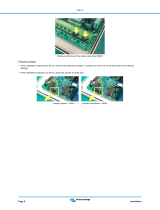
3
Contents
1 Introduction.................................................... 4
1.1 Package Contents ........................................................... 4
1.2 Specifications ................................................................. 5
1.3 Supported AGP VGA Cards List ..................................... 8
1.4 Motherboard Layout ....................................................... 10
1.5 ASRock I/O
TM
................................................................... 12
2 Installation ...................................................... 13
Pre-installation Precautions .................................................. 13
2.1 CPU Installation ............................................................... 14
2.2 Installation of CPU fan and Heatsink .............................. 14
2.3 Installation of Memory Modules (DIMM) .......................... 15
2.4 Expansion Slots (PCI, AMR, and AGI Slots) ................... 16
2.5 Easy Dual Monitor Feature .............................................. 17
2.6 Jumpers Setup ................................................................ 17
2.7 Onboard Headers and Connectors ................................ 18
3 BIOS Setup ...................................................... 20
3.1 BIOS Setup Utility ............................................................ 20
3.1.1 BIOS Menu Bar ..................................................... 20
3.1.2 Legend Bar ........................................................... 20
3.2 Main Menu ....................................................................... 21
3.3 Advanced, Security, Power, Boot, and Exit Menus ...... 23
4 Software Support ........................................... 24
4.1 Installing Operating System ............................................ 24
4.2 Support CD Information ................................................... 24
4.2.1 Running Support CD ............................................. 24
4.2.2 Drivers Menu ........................................................ 24
4.2.3 Utilities Menu ......................................................... 24
4.2.4 ASRock “PC-DIY Live Demo” Program ................. 24
4.2.5 Contact Information ............................................... 24
Appendix ........................................................... 25
1. Advanced BIOS Setup Menu.......................................... 25
2. Security Setup Menu ...................................................... 29
3. Power Setup Menu ......................................................... 30
4. Boot Setup Menu ............................................................ 31
5. Exit Menu ......................................................................... 32




















